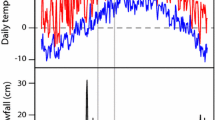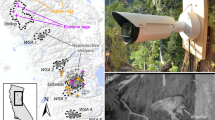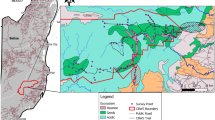Abstract
Context
Species that use open patches in forested landscapes often select clearcuts. However, it is unknown whether local associations with clearcuts translate to an effect of clearcut amount in the surrounding landscape on occupancy or abundance at local sites. This question is important because forest management decisions are made at landscape scales.
Objectives
We examined whether the amount of clearcut in the surrounding landscape influenced site occupancy of two threatened aerial insectivores, Common Nighthawk and Eastern Whip-poor-will. Both species nest in/near clearcuts at a local-scale.
Methods
We used acoustic recorders placed on edges of recent clearcuts (≤ 15 years old, n = 49 sites) to measure presence-absence. We estimated occupancy in relation to the proportion of clearcut and open wetland within the surrounding landscapes at spatial extents between 0.5 and 5.0 km.
Results
Occupancy of Eastern Whip-poor-will was not related to clearcut amount in the surrounding landscape at any scale. Common Nighthawk occupancy was lower in sites surrounded by landscapes with higher proportion of older (11–15 years old) clearcuts. Both species’ occupancy was higher in sites where the surrounding landscapes had higher proportions of open wetland.
Conclusions
Two possible mechanisms for our results include multi-scale selection of breeding sites or demographic responses to higher productivity in wetlands than clearcuts; both need further study. Our results show how the association of species with clearcut habitats at a local scale does not necessarily translate to a higher occurrence of those species at the landscape scale at which management decisions are made.






Similar content being viewed by others
References
Akresh ME, King DI (2016) Eastern Whip-poor-will breeding ecology in relation to habitat management in a pitch pine-scrub oak barren. Wildl Soc Bull. https://doi.org/10.1002/wsb.621
Alexander I, Cresswell B (1990) Foraging by nightjars caprimulgus-europaeus away from their nesting areas. IBIS 132:568–574
Barton K (2018) MuMIn: multi-model inference. https://cran.r-project.org/web/packages/MuMIn/MuMIn.pdf. Accessed 15 Aug 2018
Brennan J, Bender DJ, Conteras TA, Fahrig L (2002) Focal patch landscape studies for wildlife management: optimizing sampling effort across scales. In: Liu J, Taylor WW (eds) Integrating landscape ecology into natural resource management. Cambridge University Press, Cambridge, pp 68–91
Brigham RM, Fenton MB (1991) Convergence in foraging strategies by two morphologically and phylogenetically distinct aerial insectivores. J Zool 223:475–489
Brigham RM, Ng J, Poulin RG, Grindal SD (2011) Common nighthawk (Chordeiles minor). In: Poole A (ed) The birds of North America Online. Cornell Lab of Ornithology, Ithica
Burnham KP, Anderson DR (2002) Model selection and multi-model inference: a practical information-theoretic approach. Springer, New York
Chaundry-Smart RFC, Smith SM, Malcolm JR, Bellocq MI (2012) Comparison of moth communities following clear-cutting and wildfire disturbance in the southern boreal forest. Forest Ecol Manage 270:273–281
Cink CL (2002) Eastern Whip-poor-will (Antrostomus vociferous). In: Poole A (ed) The birds of North America Online. Cornell Lab of Ornithology, Ithica
Committee on the Status of Endangered Wildlife in Canada (COSEWIC) (2007) COSEWIC assessment and status report on the Common Nighthawk Chordeiles Minor in Canada. Committee on the Status of Endangered Wildlife in Canada, Ottawa, ON http://www.sararegistry.gc.ca/virtual_sara/files/cosewic/sr_chordeiles_minor_e.pdf
DeGraaf RM, Yamasaki M (2003) Options for managing early-successional forest and shrubland bird habitats in the northeastern United States. Forest Ecol Manage 185:179–191
Degregorio BA, Chiavacci SJ, Benson TJ, Sperry JH, Weatherhead PJ (2016) Nest predators of North American birds: continental patterns and implications. Bioscience 66:655–665
Downes CM, Collins BT, Damus M (2005) Canadian bird trends web site Version 2.1. Migratory Birds Conservation Division, Canadian Wildlife Service, Gatineau, Quebec
English PA, Nocera JJ, Pond BA, Green DJ (2017) Habitat and food supply across multiple spatial scales influence the distribution and abundance of a nocturnal aerial insectivore. Landscape Ecol 32:343–359
Environment Canada (2014a) Bird conservation strategy for bird conservation region 12 in Ontario and Manitoba: Boreal Hardwood Transition. Canadian Wildlife Service, Environment Canada, Ottawa, ON. http://www.nabci.net/Canada/English/pdf/BCR%2012%20ON%20FINAL_June2014.pdf
Environment Canada (2014b) Bird conservation strategy for bird conservation region 8 in Ontario Region: Boreal Softwood Shield. Canadian Wildlife Service, Environment Canada, Ottawa, ON. http://www.nabci.net/Canada/English/pdf/BCR%208%20ON%20FINAL_11September2014.pdf
Environment Canada (2014c) North American breeding bird survey—Canadian results and analysis website version 3.00. Environment Canada, Gatineau, Quebec. Accessed 15 June 2014
Environment Canada (2014d) North American breeding bird survey—Canadian trends website, Data-version 2012. Environment Canada, Gatineau, Quebec, K1A 0H3
Environment Canada (2015) Recovery strategy for eastern whip-poor-will (Antrostomus vociferous) in Canada. Species at Risk Act Recovery Strategy Series. Environment Canada, Ottawa, pp vii +57
Environment Canada (2016) Recovery strategy for common nighthawk (Chordeiles minor) in Canada. Species at Risk Act Recovery Strategy Series. Environment Canada, Ottawa, pp vii +49
Fahrig L, Arroyo-Rodríguez V, Bennett JR, Boucher-Lalonde V, Cazetta E, Currie DJ, Eigenbrod F, Ford AT, Harrison SP, Jaeger JA, Koper N (2019) Is habitat fragmentation bad for biodiversity? Biol Conserv 230:179–186
Farrell CE, Wilson S, Mitchell G (2017) Assessing the relative use of clearcuts, burned stands, and wetlands as breeding habitat for two declining aerial insectivores in the boreal forest. For Ecol Manage 386:62–70
Fiske I, Chandler R (2017) unmarked: an R package for fitting hierarchical models of wildlife occurrence and abundance. J Stat Softw 43:1–23
Garlapow RM (2007) Whip-poor-will prey availability and foraging habitat: implications for management in a pitch pine/scrub oak barren habitats. Masters Thesis. University of Massachussets
Hins C, Ouellet J, Dussault C, St-Laurent M (2009) Habitat selection by forest-dwelling caribou in managed boreal forest of eastern Canada: evidence of a landscape configuration effect. For Ecol Manage 31:636–643
Hoffman T (2018) MoonCalc. https://www.mooncalc.org/#/48.9225,90.5057,3/2018.06.19/11:28/1/0. Accessed 19 June 2018
Hollander FA, Van Dyck H, Martin GS, Titeux N (2011) Maladaptive habitat selection of a migratory passerine bird in a human-modified landscape. PLoS ONE 6:e25703
Hovick TJ, Miller JR (2013) Broad-scale heterogeneity influences nest selection by Brown-headed Cowbirds. Landscape Ecol 28:1493–1503
Hurvich CM, Tsai CL (1989) Regression and time series model selection in small samples. Biometrika 76:297–307
Hutto RL, Hejl SJ, Preston CR, Finch D (1993) Effects of silvicultural treatments on forest birds in the Rocky Mountains: implications and management recommendations. In: Finch DM, Stangel PW (eds) Status and management of neotropical migratory birds. U.S. Dep. Agric. For. Ser. Gen. Tech. Rep. RM-229, pp 386–391
Iglay RB, Miller DA, Leopold BD, Wang G (2012) Carabid beetle response to prescribed fire and herbicide in intensively managed, mid-rotation pine stands in Mississippi. For Ecol Manage 281:41–47
Jackson HB, Fahrig L (2015) Are ecologists conducting research at the right scale? Global Ecol Biogeogr 24:52–63
Jedlikowski J, Chibowski P, Karasek T, Brambilla M (2016) Multi-scale habitat selection in highly territorial bird species: exploring the contribution of nest, territory and landscape levels to site choice in breeding rallids (Aves: Rallidae). Acta Oecol 73:10–20
Jones J (2001) Habitat selection studies in avian ecology: a critical review. Auk 118:557–562
Kellner KF, Ruhl PJ, Dunning JB, Riegel JK, Swihart RK (2016) Multi-scale responses of breeding birds to experimental forest management in Indiana, USA. For Ecol Manage 382:64–75
Kirk DA, Hobson KA (2001) Bird-habitat relationship in jack pine boreal forests. For Ecol Manage 147:217–243
Knight EC, Ng JW, Mader CE, Brigham RM, Bayne EM (2018) An inordinate fondness for beetles: first description of common nighthawk (Chordeiles minor) diet in the boreal biome. Wilson J Ornithol 130:525–531
Lee M, Fahrig L, Freemark K, Currie DJ (2002) Importance of patch scale vs landscape scale on selected forest birds. Oikos 96:110–118
Legrand HG, Chamberlain MJ, Moser EB (2007) Diversity and abundance of breeding birds in a managed loblolly pine forest in Louisiana. Am Midl Nat 157:329–344
Lehnen SE, Rodewald AD (2009) Investigating area-sensitivity in shrubland birds: responses to patch size in a forested landscape. For Ecol Manage 257:2308–2316
Mackenzie DI, Nichols JD, Lachman GB, MacKenzie DI, Nichols JD, Lachman GB, Droege S, Andrew Royle J, Langtimm CA (2002) Estimating site occupancy rates when detection probabilities are less than one. Ecology 83:2248–2255
McRae DJ, Duchesne LC, Freedman B, Lynham TJ, Woodley S (2001) Comparisons between wildfire and forest harvesting and their implications in forest management. Environ Rev 9:223–260
Mills AM (1986) The influence of moonlight on the behavior of goatsuckers (Caprimulgidae). Auk 2:370–378
Moorman CE, Russell KR, Greenberg CH (2011) Reptile and amphibian response to hardwood forest management and early successional habitats. In: Greenberg C, Collins BS, Thompson F III (eds) Sustaining young forest communities in managing forest ecosystems series, vol 21. Springer, Dordrecht, pp 191–208
Natural Resources Canada (NRCAN) (2017) 8 facts about Canada’s boreal forest. https://www.nrcan.gc.ca/forests/boreal/17394. Accessed 6 July 2018
Naugle DE, Higgins KF, Nusser SM, Carter JW (1999) Scale-dependent habitat use in three-species of prairie wetland birds. Landsc Ecol 14:267–276
Nebel S, Mills A, McCracken JD, Taylor PD (2010) Declines of aerial insectivores in North America follow a geographic gradient. Avian Conserv Ecol 5:1
Nielsen SE, Boyce MS, Stenhouse GB (2004) Grizzly bears and forestry I: selection of clearcuts by grizzly bears in west-central Alberta, Canada. For Ecol Manage 199:51–65
Ontario Ministry of Natural Resources (OMNRF) (2010) Forest management guide for conserving biodiversity at the stand and site scales. Toronto: Queen’s Printer for Ontario, p 211. https://docs.ontario.ca/documents/4816/stand-amp-site-guide.pdf. Access 9 April 2019
Ontario Ministry of Natural Resources and Forestry (OMNRF) (2014) Forest resources inventory technical specifications 2009. Queen’s Printer for Ontario. Peterborough, On. https://dr6j45jk9xcmk.cloudfront.net/documents/2837/fim-tech-spec-forest-resources-inventory.pdf. Accessed 19 July 2018
Ontario Ministry of Natural Resources and Forestry (OMNRF). (2018a) Management units and forest management plan renewal schedules. https://www.ontario.ca/page/management-units-and-forest-management-plan-renewal-schedules#section-0. Accessed 19 June 2018
Ontario Ministry of Natural Resources and Forestry (OMNRF). (2018b) Ontario’s forest regions. https://www.ontario.ca/page/forest-regions. Accessed 4 July 2018
Pickens BA, King SL (2014) Multiscale habitat selection of wetland birds in the northern Gulf Coast. Estuaries Coasts 37:1301–1311
Poulin RG, Grindal SD, Brigham RM (1996) Common Nighthawk (Chordeiles minor). In: Poole A, Gill F (eds) The Birds of North America, No. 213. The Academy of Natural Sciences, Philadelphia, PA, and the American Ornithologists’ Union, Washington, DC
Purves E. (2015) The role of breeding habitat loss in the decline of Eastern Whip-poor-will (Antrostomus vociferous) populations in Canada. Masters Thesis. Queen’s University
R Core Team (2017) R: A language and environment for statistical computing. R Foundation for Statistical Computing, Vienna, Austria. https://www.R-project.org/
Rand GJ (2014) Home range use, habitat selection, and stress physiology of Eastern Whip-poor-wills (Antrostomus vociferus) at the northern edge of their range. Msc. Thesis, Trent University
Raynor GS (1941) The nesting habits of the Whip-poor-will. Bird-Banding 12:98–104
Reitsma LR, Holmes RT, Sherry TW (1990) Effects of Removal of red squirrels, Tamiasciurus hudsonicus, and Eastern Chipmunks, Tamias striatus, on nest predation in a northern hardwood forest: an artificial nest experiment. Oikos 57 (3):375–380
Robertson BA (2009) Nest-site selection in a postfire landscape: do parents make tradeoffs between microclimate and predation risk? Auk 126:500–510
Rowe JF, Scotter GW (1973) Fire in the boreal forest. Quatern Res 3:444–464
Rushing CS, Ryder TB, Marra PP (2016) Quantifying drivers of population dynamics for a migratory bird throughout the annual cycle. Proc R Soc B 283:2015–2846
Russell RE, Royle JA, Saab VA, Lehmkuhl JF, Block WM, Sauer JR (2009) Modeling the effects of environmental disturbance on wildlife communities: avian responses to prescribed fire. Ecol Appl 19:1253–1263
Shin D, Yoo J (2016) Reproductive success of Eurasian eagle-owls in wetland and non-wetland habitats of west-central Korea. J Raptor Res 50:241–253
Smith CE (2012) Initial response of amphibian and small mammal species to timber and coarse woody debris harvest in aspen-dominated forests of northern Minnesota. MSc Thesis. Retrieved from the University of Minnesota Digital Conservancy, http://hdl.handle.net/11299/122207. Accessed 15 July 2018
Spitzer K, Danks HV (2006) Insect biodiversity of boreal peat bogs. Annu Rev Entomol 51:137–161
Sponsler DB, Johnson RM (2015) Honey bee success predicted by landscape composition in Ohio, USA. PeerJ 3:e838
Stark JD, Chen XD, Johnson CS (2012) Effects of herbicides on Behr’s metalmark butterfly, a surrogate species for the endangered butterfly, Lange’s metalmark. Environ Pollut 164:24–27
Stelfox JB (1995) Relationships between stand age, stand structure, and biodiversity in aspen mixedwood forests in Alberta. Alberta Environmental Centre and Canadian Forest Service, Vegreville and Edmonton, p 308
Stenger JM, Rehm-Lorber JA, White CM, Pavlacky DC Jr (2011) Monitoring the Birds of Agate Fossil Beds National Monument: 2010 Annual Report. Rocky Mountain Bird Observatory, Brighton
Streby HM, Andersen DE (2013) Movements, cover-type selection, and survival of fledgling ovenbirds in managed deciduous and mixed coniferous-deciduous forests. For Ecol Manage 287:9–16
Tews J, Brose U, Grimm V, Tielbörger K, Wichmann MC, Schwager M, Jeltsch F (2004) Animal species diversity driven by habitat heterogeneity/diversity: the importance of keystone structures. J Biogeogr 31:79–92
Thompson DG, Pitt DG (2011) Frequently asked questions (FAQs) on the use of herbicides in Canadian Forestry. Frontline Forestry Research Applications, Canadian Forest Service. Sault Ste. Marie, ON. http://www.cfs.nrcan.gc.ca/pubwarehouse/pdfs/32344.pdf. Accessed 15 May 2019
Tozer DC, Hoare JC, Inglis JE, Yaraskavitch J, Kitching H, Dobbyn S (2014) Clearcut with seed trees in red pine forests associated with increased occupancy by Eastern Whip-poor-wills. For Ecol Manage 330:1–7
Tremblay JA, Ibarzabal J, Dussault C, Savard JL (2009) Habitat requirements breeding black-backed woodpeckers (Picoides arcticus) in managed, unburned, boreal forest. Avian Conserv Ecol 4:2
Twedt DK (2015) Estimating regional landbird populations from enhanced North American Breeding Bird Surveys. J Field Ornithol 86:352–368
White CG, Schweitzer SH, Moore CT, Parnell IB III, Lewis-Weis LA (2010) Evaluation of the landscape surrounding Northern Bobwhite nest sites: a multiscale analysis. J Wildl Manage 69:1528–1537
Wilson S, Ladeau SL, Tøttrup AP, Marra PP (2011) Range-wide effects of breeding and non–breeding season climate on the abundance of a Neotropical migrant songbird. Ecology 92:1789–1798
Wilson MD, Watts BD (2006) Effect of moonlight on detection of Whip-poor-wills: implications for long-term monitoring strategies. J Field Ornithol 77:207–211
Wilson MD, Watts BD (2008) Landscape configuration effects on distribution and abundance of Whip-poor-wills. Wilson J Ornthol 120:778–783
Zimmerling JR, Francis CM, Roy C, Calvert AM (2017) How well does forestry in Ontario’s boreal forest emulate natural disturbances from the perspective of birds? Avian Conserv Ecol 12(2):10
Acknowledgements
This work was funded through the National Wildlife Research Centre of Environment and Climate Change Canada and a Natural Sciences and Engineering Research Council of Canada (NSERC) grant to LF. We thank our field assistants Amanda Findlay and Cameron Leitrants for their help in collecting data and Gabriel Blouin-Demers and Rob Mackereth for their assistance in the development of this project. We also thank Gabriel Blouin-Demers, Stacey Robinson, and Steve Cooke for their insightful comments.
Author information
Authors and Affiliations
Corresponding author
Additional information
Publisher's Note
Springer Nature remains neutral with regard to jurisdictional claims in published maps and institutional affiliations.
Electronic supplementary material
Below is the link to the electronic supplementary material.
Rights and permissions
About this article
Cite this article
Farrell, C.E., Fahrig, L., Mitchell, G. et al. Local habitat association does not inform landscape management of threatened birds. Landscape Ecol 34, 1313–1327 (2019). https://doi.org/10.1007/s10980-019-00843-6
Received:
Accepted:
Published:
Issue Date:
DOI: https://doi.org/10.1007/s10980-019-00843-6




